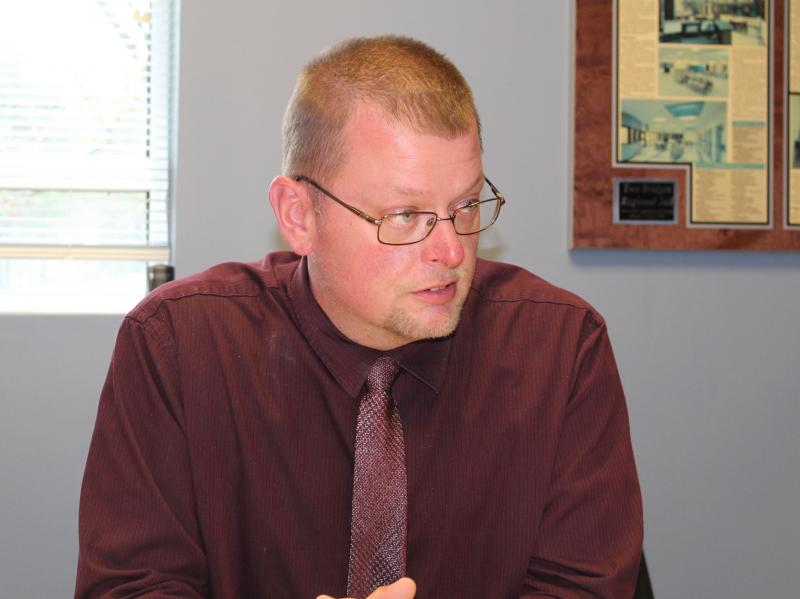Bailey: Jail to specialize in drug treatment
In July, Two Bridges Regional Jail in Wiscasset will lose one of its longtime boarding counties, Waldo County, and with it, a nearly million-dollar contract.
However, Col. James Bailey, jail administrator, said it opens a valuable door.
“We are hoping to dedicate an entire pod to medication-assisted drug treatment,” the use of medication and behavior management to help overcome addictions, he said. Also involved are wrap-around services for success on the outside, such as continuing treatment, job placement, and halfway housing.
“Every person in our jail will be getting out, sooner or later,” he said. “Many, many people have a drug-associated reason for ending up here in the first place.” Bailey pointed out that in addition to drug trafficking and possession charges, a lot of burglaries, assaults, OUIs, and other crimes are drug-related. “People break in to steal something to feed their habit. Or they get into an altercation with someone about drugs, or they get behind the wheel under the influence,” he said. “Our goal has got to be to stop them from coming back.”
At $160-$180 estimated cost per inmate per day in the jail, the savings the counties can realize if former inmates get the help they need and get on with their lives successfully is huge, he said. “Every single inmate stopped from coming back represents a huge savings,” he said.
Right now, the jail is like an emergency room setting, Bailey said. People come in drug-sick, or high, and have to be treated before they can join the rest of the population. “We are already working with people in treatment programs on the outside,” he said. “We verify that the person is in treatment, and is compliant.” This is done with urine tests which continue randomly in jail. “If they already have a prescription, we provide them with their medication while they are in jail.” Bailey said suboxone and vivitral are some of the common medications inmates are on when they come in.
The jail is not set up to identify and prescribe for addicted inmates not in recovery programs when arrested. That’s the major change that Bailey wants. “We want to identify up to 48 beds in a single pod for male inmates suffering from addiction, and a smaller number of beds in part of the women’s pod for female inmates,” he said. “The real question is how we are planning to do this.”
There are essentially two options, he said. The first is a grant-funded program through the Department of Health and Human Services’ Substance Abuse program that would turn over treatment programs to a company called Enzo Recovery. Enzo has been working in York and Kennebec counties. Lincoln County Sheriff Todd Brackett and Sagadahoc County Sheriff Joel Merry are looking at the Addiction Resources Center, which currently offers programs in the jail and elsewhere. “I understand why the sheriffs want to bring ARC into the loop,” Bailey said. “They’ve done really good work for us, and they’re good at what they do.” He said the problem would be that the jail would have to fund a program with ARC, while the program with Enzo would be fully covered by the state every year. The jail does not have to sign a long term contract with Enzo, so if it is tried and doesn’t work out, the jail could try something different in future years.
Bailey suggested ARC could play more of a wrap-around role, providing treatment after inmates are released, helping with the housing component, and working with the main population that would not be part of the specialized MAT program, while the jail would accept the state’s funding for the Enzo program in the specialized unit. Funding is expected to be renewed annually; each grant is for a one-year program.
If ARC is used instead, Bailey said, the counties would have to increase their cap funding for the jails, find more grant funding, and Bailey would have to set up a plan to recoup the costs from out of area inmates. “We will have to look at all the costs involved in running the program, including hiring specially trained staff members.” He said it would all come down to funding, and the willingness to work with any outside agency with a MAT program. Enzo, which already has the state’s contract, has already agreed to do this.
He said there is already interest from other counties who cannot run such a program themselves. “Franklin County has already reached out, and is sending us an inmate in June,” he said. “Right now that’s just medication management, but the inmate might be a good match for a program like this.”
Inmates who wished to be part of the MAT program would complete an assessment and sign a contract. There would be a three-hour program daily, five days per week. Enzo also runs two sobriety houses in the Augusta area, and is looking at a couple of properties near the jail to open sobriety houses in Lincoln County.
Co-occurring disorders, such as mental health issues, would be treated at the same time.
Bailey said if a coastal Drug Court comes to Lincoln or Knox County, an idea still on the appropriations table, it is possible inmates would be given the option of working with the MAT program at TBRJ as part of their sentencing. Knox County's jail, which has been reorganizing itself as a facility that helps outgoing inmates find housing and jobs, could be a key partner, Bailey said.
The MAT program, in addition to helping addicted inmates cure their addictions, would benefit Lincoln, Sagadahoc and other counties, Bailey said. “We could be the flagship for this type of program. Smaller jails and jails that can’t afford medical technicians could send specific inmates to us, pay our rate per inmate, and still be within the law.” Sagadahoc and Lincoln would benefit from higher cost recovery per inmate, and the move would save some 15 jobs at the jail.
Bailey said he sees this as an opportunity. “I don’t see brick walls,” he said. “I see hammers to knock down walls.”
The Authority has convened a strategic planning committee, including one commissioner from each county, Hamilton Meserve and Charles Crosby, the two sheriffs, the two county administrators, the chair of the authority, Peter Lepari, and Bailey. MAT is high on the committee’s list of priorities, along with deciding to use reserve funds or surplus to make up the deficit.
A special authority meeting will be held in June to decide how to proceed. Bailey expects that if all goes well, the new MAT program could begin as early as August.
“I just need to remind everyone that these inmates were our neighbors, and will be our neighbors again,” he said. “We need to help them be functioning members of our community.”
Event Date
Address
United States
























